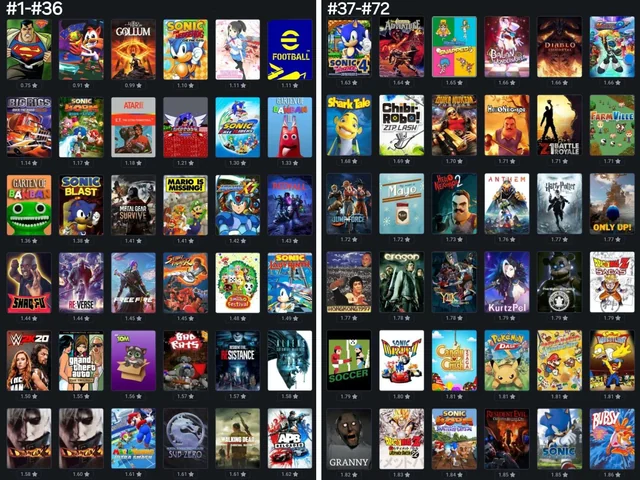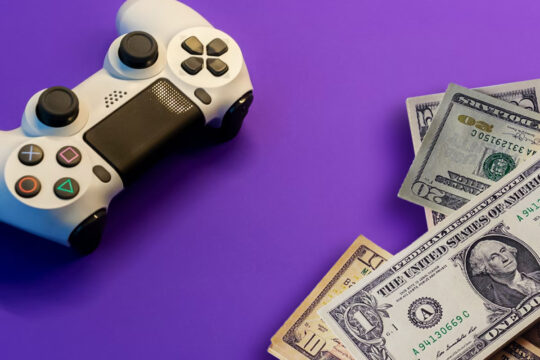Bad video games share an interesting twist – they somehow make it to store shelves despite being terrible. E.T. the Extraterrestrial for Atari 2600 remains the grandfather of awful games. People still talk about it as one of the worst creations that ever spread through the gaming world. The game sold over half a million copies worldwide when it launched.
The game’s legacy turned out nowhere near as positive as its original sales numbers suggested. E.T. holds the record for the lowest review score in Metacritic history – a measly 8 out of 100. This shows how even the worst games can find their way to consumers. Some terrible games weren’t accidents at all. To name just one example, see Stalin vs Martians. Developers meant to create a parody of real-time strategy games, yet critics slammed its “mind-numbing action and ridiculously confusing level design”. These notorious titles left their mark on gaming history. They helped crash the industry, shrinking a $3 billion market to just $100 million, and even shut down entire development studios.

The Rise of Bad Games: A Historical Perspective
The early 1980s digital world taught us what happens when quantity beats quality. Before Nintendo and PlayStation took over our living rooms, Atari ruled the home video game world—until everything came crashing down.
The early days of gaming and the Atari crash
The video game industry’s first major collapse hit between 1983 and 1985. The North American market shrank by a shocking 97%—dropping from $3.2 billion to just $100 million. This massive downturn had several connected causes. We flooded the market with too many consoles and games, which left consumers confused and overwhelmed by choices.
The success of the late 1970s and early 1980s pushed companies to make games faster without checking quality. A key court case against Atari opened the doors for any company to create games for any device, which removed quality control. This meant companies with no gaming experience—like Quaker Oats and Purina Dog Food—started making games, and the market filled up with low-quality products.
Everything reached a breaking point in 1982. Market experts noticed manufacturers had boosted production by 175% while customer demand grew only 100%. Too many products and poor quality created the perfect storm.
How E.T. for Atari became the poster child of failure
E.T. the Extra-Terrestrial for the Atari 2600 stands out as the best example of this era’s mistakes. The game had huge potential because of Steven Spielberg’s blockbuster movie. Notwithstanding that, Atari’s leaders made a huge mistake. They gave programmer Howard Scott Warshaw only five weeks to create the entire game to hit the 1982 holiday season.
This rush job led to confusing gameplay, bad graphics, and a broken experience. Players got lost instead of challenged—a key difference in game design. Atari made five million cartridges but sold only 1.5 million, and many buyers wanted their money back.
The story’s most famous moment came when Atari secretly buried about 728,000 unsold cartridges (including E.T. and other games) in a New Mexico landfill. People found these games during a 2014 dig, which proved this legendary gaming disaster was real.
Lessons the industry failed to learn
The video game industry keeps making the same mistakes as E.T. The basic truth—rushed development with impossible deadlines leads to disasters—still affects publishers today.
Nintendo brought life back to the industry in 1985 with the Nintendo Entertainment System. They set up strict quality checks that Atari never had. Nintendo’s president Hiroshi Yamauchi said it best in 1986: “Atari collapsed because they gave too much freedom to third-party developers and the market was swamped with rubbish games”.
Unfortunately, publishers through the years kept making similar mistakes. They rushed deadlines, hyped games too much, and cared more about release dates than quality, especially when they had licensed properties. The industry promised too much and delivered too little. Technology moved faster, but business practices stayed nowhere near as quick to change.

When Greed Takes Over: Rushed and Licensed Disasters
Licensed video games have earned a reputation as some of the worst games ever made. The combination of intellectual property rights and rushed development cycles keeps producing disasters that rank at the bottom of gaming quality.
The curse of movie tie-in games
Movie tie-in games follow a flawed business model. Release schedules must match film premieres, creating deadlines that put marketing ahead of quality. A developer explained this shift: “the main reasons things are better now is that more people understand games in general, there’s more trust on both sides, and film tie-ins are now a lot more focused on fitting into a franchise overall”.
Standard games can delay their release when issues pop up. Movie tie-ins don’t have this luxury. This puts talented developers in tough spots. Many great studios had to rush out mediocre licensed products just to keep the lights on before creating their outstanding original titles.
Why licensed games often fail
Licensed games struggle under unique pressures. Short development cycles leave no time to polish gameplay properly. Too many stakeholders complicate every decision. James Parker’s experience with the failed Catwoman game highlights this: “There was a large number of stakeholders that needed consultation on everything, which would have been fine if the team wasn’t being asked to work to an incredibly tight deadline”.
Changes to movie assets create a domino effect throughout development. Game developers must scramble to update their work when film elements change. Teams end up focusing on making things look pretty instead of making them play well.
The market’s expectations tell the real story. An industry observer put it bluntly: “Since you’ve already got a committed audience, why not skimp on the work, half-ass it and see the sales come in on name value alone?”. This explains why many of the worst video games of all time carry Hollywood brands.
Examples: Superman 64, The Simpsons Wrestling, Shrek 2
Superman 64 stands as the most infamous licensed disaster. IGN’s reviewer called it “one of the ugliest games I have ever seen” and “the most horrific demolition of a license ever”. Players got stuck in endless ring-flying sequences through a “Kryptonite fog” – actually a technical limitation masked as a plot device. The game’s broken controls let players clip through walls. GameSpot declared it “easily the worst game I’ve ever played”.
The Simpsons Wrestling crashed and burned. IGN labeled it “garbage” and “the kind of throwback license shovelware that Acclaim used to crank out back in the Genesis days”. Critics slammed its “choppy looking” graphics, broken character outlines, and terrible collision detection. One review noted it “does not even hold any wrestling qualities at all”. Players just mashed buttons with no skill needed.
Shrek 2 sold well but had major issues. The game suffered from stuttering framerates and boring puzzles. AI teammates proved useless – they “frequently die in battle and slack off during group mini-games”. Technical problems made the frame rate bounce between 38 and 60 FPS randomly.
These failures show how licensed games sacrifice quality to meet marketing deadlines. Brand recognition can’t save a broken game.
Ambition Without Direction: Games That Tried Too Hard
Gaming history has seen its share of spectacular failures. These weren’t just bad games – they became legendary disasters because their creators dreamed too big without the skills to deliver. These games earned their spot as the worst video games of all time not from lack of imagination, but because they tried to reach for the stars and crashed hard.
Overpromising and underdelivering
The biggest flops in gaming started with huge promises. Developers sold dreams of game-changing features, state-of-the-art visuals, and never-before-seen innovations. They set expectations so high that failure became inevitable. This trend of overselling has turned many marketing campaigns into warnings about trusting developer promises too much.
Take Peter Molyneux’s famous claim about Fable – he said players could plant acorns and watch them grow into trees. That feature never showed up in the game. No Man’s Sky promised players a huge multiplayer universe but launched without it. The company faced lawsuits for misleading ads.
The case of Daikatana and Too Human
Daikatana stands out as the perfect example of unchecked ambition. Fresh off his success with Doom and Quake, John Romero wanted to create something massive – 24 levels across four time periods, 64 different monsters, and 25 weapons. He thought seven months would be enough to build it all.
Things didn’t work out that way. The team switched game engines and lost eleven months of work. The game hit shelves in 2000, three years behind schedule and looking dated. Eidos needed 2.5 million sales to break even but moved just 40,000 copies by September.
The story of Too Human reads just as badly. Development dragged on for almost ten years as it jumped from PlayStation to GameCube to Xbox 360. The project burned through $60-100 million and ended up in disaster when Silicon Knights got caught stealing Epic Games’ code.
How hype can destroy a game
Games can’t live up to impossible expectations, even good ones. One industry expert put it simply: “Hype is a double-edged sword”. Marketing teams that overshadow developers set their games up for failure.
Release deadlines make this problem worse. Look at Cyberpunk 2077 – its marketing budget hit $142 million, almost matching the $174 million spent on making the game. Game industry veterans admit they often “develop trailers that contain features that don’t make it into the game”.
These massive failures teach gaming’s toughest lesson: big dreams without solid execution don’t create masterpieces – they create the worst games ever made.
The Worst Game Mechanics Ever Made
A game’s controls connect players to their virtual world. Bad controls can destroy even the most promising games. The gaming industry has seen some spectacular failures where broken mechanics made simple actions impossible.
Broken controls and unplayable design
Every worst game ever made has failed at something basic. Game mechanics aren’t just features. They shape how players interact with the digital world. Failed systems can ruin the entire experience. Players face nightmares with buttons that don’t work, physics that make no sense, and cameras that won’t behave.
On top of that, problems with collision detection let objects pass through each other. Players walk through walls or fall through floors. These aren’t small issues. They completely destroy any chance of immersion or playability.
Examples: Bubsy 3D, Big Rigs: Over the Road Racing
Bubsy 3D shows what happens when developers don’t understand basic 3D design. The 1996 PlayStation game had “tank-like” controls that made simple movement a challenge. A terrible camera system made things worse. Players couldn’t guide their character through basic environments. The game launched months after the revolutionary Super Mario 64 but looked awful with flat textures and confusing level design.
Big Rigs: Over the Road Racing stands as the lowest point in game design. This 2003 PC game wasn’t just bad – it was unfinished. Trucks could drive through buildings and bridges. The broken physics let vehicles climb straight up cliffs. Driving backward let players reach infinite speeds. Nothing in the environment worked as an obstacle because collision detection didn’t exist.
The game’s opponents either stood still or stopped right before the finish line after updates. Players couldn’t lose. The experience ended with the now-famous “YOU’RE WINNER!” victory screen, complete with bad grammar and a trophy with three handles.
Why bad mechanics ruin everything
Bad mechanics break the link between what players want to do and what happens. Players press buttons expecting something specific. Random responses destroy their connection to the game.
Beautiful graphics and amazing stories mean nothing when players can’t control their character or understand the game world. That’s why Bubsy 3D and Big Rigs remain notorious after so many years. Their broken mechanics weren’t just flaws – they made the games impossible to play.
Modern Failures: Monetization, Gacha, and Live Service Flops
Modern gaming’s worst offenders hide behind seemingly free experiences and use sophisticated psychological tactics to get maximum revenue from players. The digital world has seen a fundamental change from one-time purchases to ongoing monetization schemes that target vulnerable players.
The rise of predatory game design
The gaming industry now depends on manipulative design patterns that exploit psychological vulnerabilities. Gacha mechanics—which take inspiration from Japanese capsule toy machines—push players to spend real money on randomized virtual items with terrible drop rates, sometimes as low as 0.6% for desirable characters. These systems use the “threshold effect” where small original purchases lead players toward bigger spending. Developers create lottery recharge exchange ratios that build sunk costs and pressure players to spend more.
Dead or Alive Xtreme: Venus Vacation and gacha traps
Dead or Alive Xtreme: Venus Vacation shows predatory monetization at its worst. This mobile gacha game runs almost entirely on timers and players get one “Festival Point” every 10 minutes. Players face paid-only banners for coveted items like bride costumes, with no pity system for unlucky players. The game has mechanics that let players “soften or firm up” female characters’ body parts, which turns objectification into a money-making strategy.
How live service games fail players
The gaming world has many abandoned live service projects. Sony’s planned live service games saw at least five cancellations, while others like Destruction All-Stars and Concord failed soon after launch. Big-budget titles like Anthem collapsed despite years of development—its revival plans ended up canceled due to high costs. These failures come from flawed business models that put monetization before gameplay and leave players stuck in dying ecosystems.
Modern gaming’s biggest failures aren’t technical disasters but ethical ones—games built to manipulate players into overspending through engineered psychological traps.
Summing all up
Bad video games have become warning signs in gaming history that show what happens when development goes wrong. The notorious burial of E.T. games in a landfill and the broken English “YOU’RE WINNER!” screen in Big Rigs tell similar stories. These massive failures teach us how tight deadlines, too much hype, and money-first thinking lead to disaster.
Game publishers keep making the same mistakes. The Atari crash taught clear lessons about flooding the market with low-quality games, yet modern publishers still push out unfinished products. Technology has come a long way, but companies still rush to meet release dates instead of polishing their games. Licensed games suffer the most, with Superman and The Simpsons getting some of gaming’s worst adaptations.
Without doubt, terrible games have evolved beyond just broken mechanics. The worst offenders in modern gaming now use clever psychological tricks with gacha systems and aggressive monetization. The meaning of “worst games” now includes both unplayable messes and games that exploit vulnerable players.
These gaming disasters are more than just failed entertainment. The video game industry makes more money than movies and music combined, which is a big deal as it means that these failures have real economic impact. The worst games ever made remind us that creativity needs proper execution and quality takes time. Players deserve better than rushed money-grabs disguised as entertainment.
Here are some FQAs about the worst video games of all time:
What is the most disliked game ever?
The title of most disliked game ever is often given to “E.T. the Extra-Terrestrial” for the Atari 2600, which was so poorly received that unsold copies were famously buried in a landfill. More recently, games like “Ride to Hell: Retribution” frequently appear on lists of the worst video games of all time due to their numerous technical and design flaws.
What is the lowest rating game?
Games like “Big Rigs: Over the Road Racing” have received some of the lowest ratings in history, including scores as low as 1/10 from major publications. These titles consistently appear on the worst video games of all time ign lists and other compilations of critically panned games.
What is the most unsuccessful video game?
The most unsuccessful video game in terms of commercial performance is often considered to be “Plumbers Don’t Wear Ties,” which sold extremely poorly despite its notorious reputation. It frequently appears on lists of the worst selling video games of all time due to both its terrible quality and minimal sales.
What is the #1 best game ever?
The title of #1 best game ever is highly subjective and varies by publication, but titles like “The Legend of Zelda: Ocarina of Time” and “Tetris” frequently top these lists. This is the complete opposite end of the spectrum from discussions about the worst game ever made.
Is it illegal to play 18+ games?
It is not illegal to play 18+ games as an adult, though selling them to minors is prohibited in most regions. This question is unrelated to discussions about the worst video games of all time, which focus on quality rather than age restrictions.
What is a cringe game?
A cringe game is typically one with awkward dialogue, poor storytelling, or attempts at humor that fall completely flat. Many titles considered among the worst video games of all time list qualify as cringe games due to their unintentionally hilarious badness.
Which game is banned in the world?
Several games have been banned in various countries, including “Manhunt” and “Postal 2” for their extreme violence. While these games are controversial, they are not necessarily among the worst game ever made in terms of quality.
Who is the No.1 game in the world?
The No.1 game in the world changes frequently, but titles like “Minecraft” and “Grand Theft Auto V” have consistently held top positions in sales and popularity charts. This stands in stark contrast to discussions about the worst selling video games of all time.



